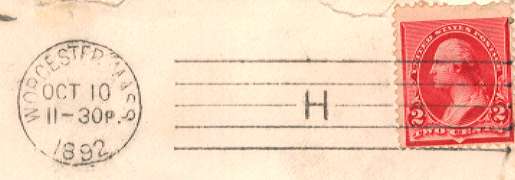
|
Worcester |
The next image is of a Machine Cancel is of an American D6-(3) dated March 14, 1893. As noted above, this machine started life as the D5-( ) machine on 15/16 September, 1892.
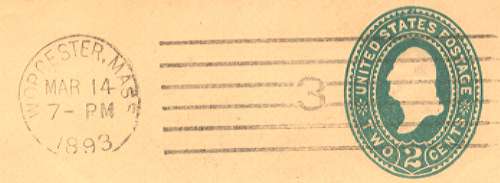
|
Worcester |
Worcester, like many cities across the country, had its share of American Flag Machine Cancels. At least 20 different varities of Flag Cancels exist for Worcester. One of the most elusive is the Style B-44 Involute Type A.
There are two Types of B-44 Involutes for Worcester - Type A and Type B, with Type A being the earlier of the two. There are a couple of ways of distinguishing the two Types. In Type A the outer wall of the star field is straight while in Type B it is curved. In Type A the stripes cross over the left fold of the wave with a great deal of misalignment while in Type B the stripes cross over this fold with a very slight amount of displacement.
The second image of a Machine Cancel is of an American Flag B-44 Type A dated June 14, 1898.
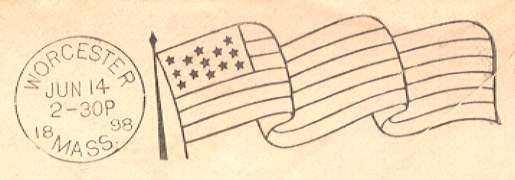
|
Worcester |
As Worcester grew in population and mail volume, additional Post Office Stations were opened around the city. Station A was located near Union Station at Washington Square. Station A employed Doremus machines. A number of examples of the different styles of Doremus Machine Cancels are shown below.
The next image is of a Doremus Style D1s K1 Machine Cancel dated February 03, 1900. It was used on outgoing mail.

|
Worcester Station A |
The next image is of a Doremus Style D1s K2 Machine Cancel dated May 11, 1900. It was used on outgoing mail.
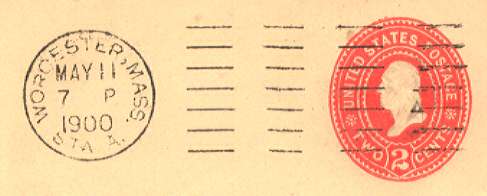
|
Worcester Station A |
The next image is of a Doremus Style D1s K3 Machine Cancel dated June 26, 1901. It was used on outgoing mail.
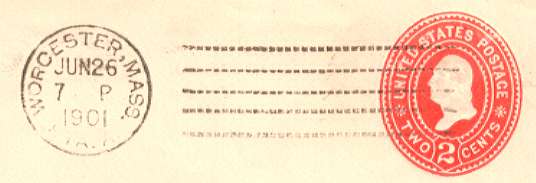
|
Worcester Station A |
The next image is of a Doremus Style D1s K4 Machine Cancel dated September 01, 1903. It was used on outgoing mail.

|
Worcester Station A |
The next image is of a Doremus Style D-8 Machine Cancel dated March 24, 1902. This Machine Cancel was normally used to backstamp incoming mail as a "RECEIVED" marking. It is evident, however, that it was also used to cancel Outgoing mail!

|
Worcester Station A |
The last image in the Doremus series is of a previously-unlisted Doremus E-Type Dial and "RECEIVED" marking for Worcester. Information about this rare cancel is sketchy as of the time of this writing, but it appears that it was only used for a very short time in 1909. I will add more details as they become available to me.

|
Worcester Station A |
In my opinion, the least-discussed Machine Cancels of Worcester, Massachusetts were those made by machines from the Columbia Company. They were used very little, mainly as "Receiver" markings applied to the backs of envelopes. The example shown below, however, was used on Outgoing mail. Two Dial Types exist. The variance between them is evident in the number of degrees "WORCESTER" extends around the circumference of the rim of the Dial. An example of a Type 2 Dial is shown below. "WORCESTER" extends less than 180 degrees around the rim of the dial. In a Type 1 Dial, "WORCESTER" extends greater than 180 degrees around the dial.
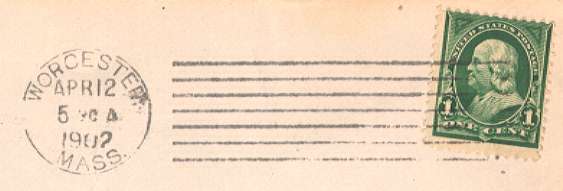
|
Worcester |
Not all Machine Cancels that were used in Worcester obliterated postage stamps. As noted above, some were used as Receiving Markings. Still others were used as special "Service Markings" on mail. The Post Office in Worcester employed a number of Service Marking Machine Cancels made by the American Postal Machine Company. They included:
AMS-11 - Dial Only - Used as a Receiving Marking - B-Type Dial.
AMS-22 - Machine Number and "RECEIVED" in Oval - B-Type Dial - Machine 1.
AMS-22 - Machine Number and "RECEIVED" in Oval - B-Type Dial - Machine 2.
AMS-31 - Station Letter and "RECEIVED" in Oval - B-Type Dial - Station A.
AMS-43 - Oblique Framed "TRANSIT" with Two Oblique Bars - B-Type Dial.
AMS-54 - Wording "TRAIN LATE - MAIL DELAYED" in Oval - B-Type Dial.
A few of these special markings are illustrated below.
The next image is of an American Service Marking AMS-22 from Machine Number 2. It is dated May 03, 1899. It was used on incoming mail to document when the letter was received in the Worcester Post Office.

|
Worcester |
The next image can be considered as a sort of "public relations" statement. At the turn-of-the-century most non-local mail moved by train. Delayed letters could make customers angry. When the delay was caused by the railroad and not the Post Office, the event was advertised quite prominently.
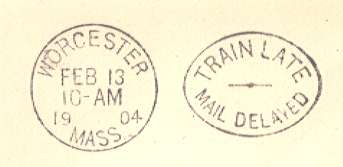
|
Worcester |
The next image of a Machine Cancel is of an American Service Marking AMS-43. It is dated September 26, 1906. This marking is normally found on the reverse of covers which passed through the Worcester Post Office for handling in transit to another office or railroad connection.
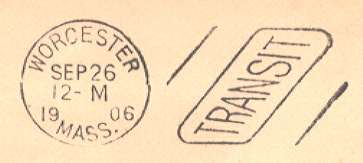
|
Worcester |
The last image in this group is of a pair of American Service Marking imprinted on the back of the same letter as it made its way from the main Worcester Post Office to Station A at Washington Square adjacent to Union Station. From Station A it was probably transferred to clerks at the railroad station where it then headed out on the next mail train. The AMS-22 Machine Cancel RECEIVED marking from Machine 1 was applied first at the Main Street Post Office. An hour later the letter had been transported a few blocks across town to Station A where it was given an AMS-31 Machine Cancel STATION A RECEIVED backstamp.

|
Worcester |
The next image below is of a Machine Cancel produced by an International machine. International machines were used in Worcester from 1902 to 1913. All cancels indicate they were produced by Machine 1. Three "designator" slugs, the letters "C", "T" and "R", were inserted in the field, depending on which type of mail was being canceled. It is conjected that "C" stood for mail that was collected from the City mail boxes, "R" stood for incoming mail from outside Worcester but for delivery in Worcester and "T" stood for mail in Transit through the Worcester Post Office to other cities. The International Machine Cancel shown is the Earliest Known Use (EKU) for this cancel in Worcester. What is interesting about this cancel is that it has been used as a Backstamp (Receiver or Transit Marking) rather than an Outgoing Mail marking. The letter designator "T" in the field would indicate that it should have been applied as a Transit Marking. However, the recipient's address on the front of the envelope shows that the letter was destined for a location in Worcester proper rather than another city. I guess the Postal Clerks did not have a full understanding of the meaning of the various letter designators during the first days of use of this machine.

|
Worcester |
In Worcester, the International Machines gave way, in 1913, to the ubiquitous Universal Machines. Most of the Universal Machine Cancels are common and mundane. However, displayed below are a couple of unusual, rare and short-lived Universal Machine Cancels. What makes them unusual and interesting is the inclusion of a "block" or a "letter" in a broken area of the wavy line killer. No other Universal Machine Cancel was used in Worcester with a similar "break" in the killer that displayed a "blank" area where the block or letter would be. However, the Dial Types used with these unusual killers do correspond to Dial Types used extensively with identified styles of Universal Machines with standard killers. Why these "special" killers with blocks or letters were used at all is a mystery.
The first image below shows a Universal Machine Cancel with a "block" in the killer. The Dial Type is BT2. Because the two bottom wavy lines have been broken to insert the "block" slug, and because the two bottom spaces have been disrupted by the insertion of the "block" slug, by convention of the Machine Cancel Society (killer lines) and me (spaces and block designator), I have designated this Machine Cancel as BT2-2012ab(BK) (2:RT).
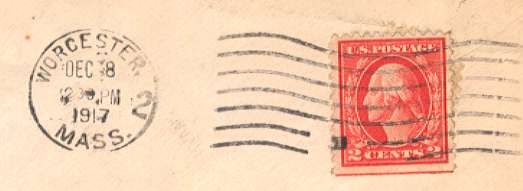
|
Worcester |
The next image below shows a Universal Machine Cancel with a "digit" in the killer. The Dial Type is #3 BT1. Using the same conventions noted above, I have designated this Machine Cancel as #3 BT1-2012ab(C).
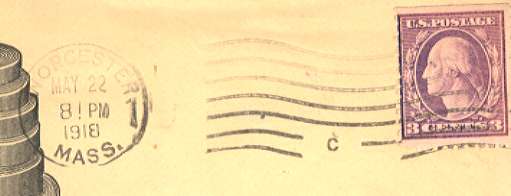
|
Worcester |
Push Icon To Get Back To Worcester Postal History Home Page!

Go To The Yahoo-GeoCities Website
